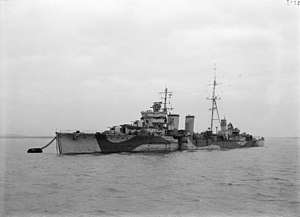HMS Caledon (D53)
 |
|
| History | |
|---|---|
|
|
|
| Name: | HMS Caledon |
| Builder: | Cammell Laird |
| Laid down: | 17 March 1916 |
| Launched: | 25 November 1916 |
| Commissioned: | 6 March 1917 |
| Decommissioned: | April 1945 |
| Reclassified: | Converted to Anti-Aircraft cruiser at Chatham Dockyard between 14 September 1942 and 7 December 1943 |
| Fate: | Sold for scrap, 22 January 1948 |
| General characteristics (as built) | |
| Class and type: | C-class light cruiser |
| Displacement: | 4,238 long tons (4,306 t) normal; 4,911 long tons (4,990 t) full load |
| Length: | |
| Beam: | 42 ft 3 in (12.9 m) |
| Draught: | 18 ft 9 in (5.72 m) (mean, deep load) |
| Installed power: |
|
| Propulsion: | 2 × shafts; 2 × geared steam turbines |
| Speed: | 29 kn (54 km/h; 33 mph) |
| Complement: | 438 |
| Armament: |
|
| Armour: |
|
| General characteristics (October 1944) | |
| Displacement: | 5,240 long tons (5,320 t) full load |
| Armament: |
|
HMS Caledon was a C-class light cruiser built for the Royal Navy during World War I. She was the name ship of the Caledon sub-class of the C class. She survived both world wars to be scrapped in 1948.
The Caledon sub-class was a slightly larger and improved version of the preceding Centaur sub-class with a more powerful armament. The ships were 450 feet 6 inches (137.3 m) long overall, with a beam of 42 feet 3 inches (12.9 m) and a deep draught of 18 feet 9 inches (5.7 m). Displacement was 4,238 long tons (4,306 t) at normal and 4,911 long tons (4,990 t) at deep load.Caledon was powered by two Parsons steam turbines, each driving one propeller shaft, which produced a total of 40,000 shaft horsepower (30,000 kW). The turbines used steam generated by six Yarrow boilers which gave her a speed of about 29 knots (54 km/h; 33 mph). She carried 935 long tons (950 t) tons of fuel oil. The ship had a crew of about 400 officers and other ranks; this increased to 437 when serving as a flagship.
The main armament of the Caledon-class ships consisted of five BL 6-inch (152 mm) Mk XII guns that were mounted on the centreline. One gun was forward of the bridge, two were fore and aft of the two funnels and the last two were in the stern, with one gun superfiring over the rearmost gun. The two QF 3-inch (76 mm) 20-cwt anti-aircraft guns were positioned abreast of the fore funnel. The torpedo armament of the Caledons was four times more powerful than that of the Centaurs, with eight 21 in (533 mm) torpedo tubes in four twin mounts, two on each broadside.
...
Wikipedia
